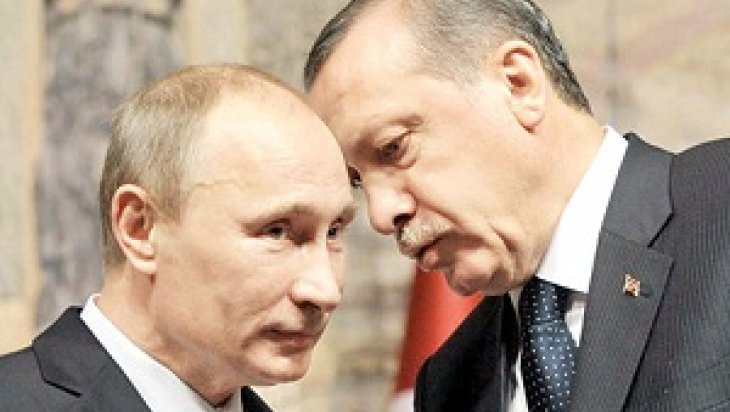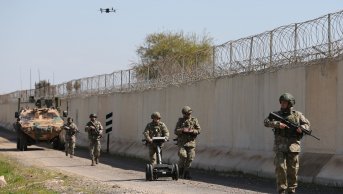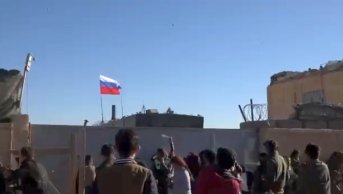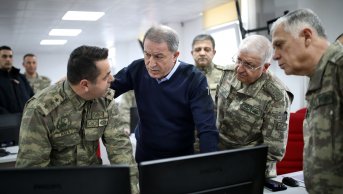What is going on in Northern Syria?

Directly interrelated and parallel developments are witnessed on the northern front which is the hottest region of the Syrian civil war. The first and most important incident among these is the efforts of the regime to besiege Aleppo with Russian support. The second important development is that Syrian Democratic Forces (SDF) led by PKK/YPG reclaimed Manbij from ISIS. Thirdly, the regime forces and the YPG/Asayish entered into a close combat and airstrikes of the regime hit YPG targets in al-Hasakah. The fourth and last development is that Turkmen and the groups affiliated with the Free Army make efforts to advance against ISIS on Azaz-Jarablus line and al-Rai (Cobanbey) was reclaimed from ISIS. Another parallel process to all these is the efforts to improve Turkey-Russia relations and the messages that three countries including Iran may cooperate in terms of Syria. In this short article, the 4 critical developments in northern Syria will be examined and they will also be evaluated within the framework of the potential Turkey-Russia-Iran cooperation in terms of Syria.
The Russian-backed regime forces and the foreign militia de facto besieged the city center of Aleppo in mid-July 2016 and completed the siege at the end of the same month. This could have been a critical development for the general course of Syrian civil war since the actor which had seized Aleppo would have gained both psychological and military advantages. While it was debated how long the opposition and civilians in Aleppo could resist to the siege, Syrian opposition was able to break the siege in the southeast of the city under the leadership of the Army of Conquest almost a week later than the siege. The success of the opposition was based on the coordinated acts of several opposition groups in and around Aleppo and the comprehensive operation it launched. This development will strengthen the idea that Syrian opposition will be successful against the regime when they act together. A similar case was also witnessed when the opposition seized Idlib. Secondly, it is understood how difficult it will be for the regime and Russia to reclaim and control Aleppo. It was estimated that the armed groups in the city would show resistance for a very long time even if the regime could continue the siege. However, the last development showed that it was even difficult to continue the siege. This difficulty may affect Russia's views about the political solution and ceasefire in Aleppo. Now that the siege is broken, Turkey will gain strength before the negotiations of Russia, Iran and Turkey about Syria.
The SDF took the control of Manbij from ISIS which had been under siege for over two months when the siege of Aleppo was broken. This development was a critical gain for YPG in order to ensure geographic integrity among its regions in northern Syria. The SDF which cannot provide geographic connection on the borderline due to Turkey's reaction and potential military intervention tries to provide connection in the south outside Turkey's howitzer range. The only purpose of the YPG is to establish a federal region under its own control in the south. In this sense, fight against ISIS is only a means for the YPG to reach its final goal. Since the YPG tries to create a zone for itself through the efforts of the USA to fight ISIS, the target following Manbij will most probably be al-Bab because this settlement is the last obstacle before the geographic integrity. If the YPG seizes al-Bab, it will reach the objective to establish an integrative region by reaching Tel Rifat. On the other hand, the priority of the USA could be al-Raqqah. The YPG could adopt a more abstaining attitude towards al-Raqqah. Al-Raqqah is an Arab province and the YPG will have difficulties in controlling it even if it takes the control. Furthermore, it will have to lose a large amount of firepower, fighters and energy since it is a large province. Even Manbij which has smaller surface area than al-Raqqah was captured after a siege for over two months. This will last longer or even end in failure in al-Raqqah.
Conflicts started between the regime and the YPG in al-Hasakah when the YPG gained strength beyond expectations and expanded its control zone. The two actors have shared al-Qamishli and al-Hasakah for a very long time without intervening in each other. Two thirds of the province of al-Hasakah belongs to the YPG whereas the regime forces control the rest. However, the regime forces and the YPG/Asayish sometimes had conflicts especially in al-Qamishli during the process. The conflicts arising for local reasons ended before becoming graver with the mediation of the officials from Damascus. Conflicts broke out in mid-August 2016 when the YPG wanted to clear the regime-led National Defense Forces from al-Hasakah and take full control. However, this time the conflicts did not end unlike the previous examples and, on the contrary, the aircrafts of the regime started to hit the targets of the YPG and Asayish. The regime forces in al-Hasakah are limited and they try to maintain its presence there with the militia since it is away from the center. It is highly possible that the YPG will be superior to the regime in the field. Therefore, the regime warned the YPG with aerial intervention against the efforts of the organization to control al-Hasakah alone. The regime showed that it would not leave al-Hasakah and it was still powerful. The regime also used this attack to give messages to Arab and Assyrian people who tended to support the YPG due to the increase in its power in northern Syria. The same evaluation was also supported by the unconfirmed news that some Assyrian and Arab groups in al-Hasakah left the YPG/SDF and passed on the side of the regime to support it. Syrian aircrafts’ hitting the targets of the YPG reminds the possibility that the relations between the regime and the PYD/YPG which have been based on non-conflict and tactical cooperation since the beginning of the civil war will be changed. If it is really so, there might be a critical development of especially how the northern Syrian front will be shaped. If the airstrikes of the regime do not constitute a message but a warning to the YPG against its violations of Syria's sovereignty rights in al-Hasakah with unilateral steps, this development should be differently evaluated. In this case, the intervention of the regime can be considered within the framework of Turkey's recent search for cooperation with Russia and Iran in terms of Syria. The mentioned three states have started to underline the territorial integrity in Syria and Iranian Minister of Foreign Affairs stated that “PKK, PJAK and PYD were of the same origin” during his visit to Turkey. Even though it is too early to make such evaluation only by considering the attack in al-Hasakah, this could be seen as a signal. Another dimension related to this issue is the role and potential reaction of the US. The US has gradually taken the PYD/YPG under control. If the YPG has taken a strategic decision to completely clear the regime from al-Hasakah, beyond the local reasons, it cannot take this step without the permission/approval/knowledge of the US. The issue has a larger dimension in this case and it means that the US considers the PYD/YPG on a superior level to local partnership in the fight against ISIS. In this conjuncture, it can be implied that the US is inclined to establish a close autonomous/federal region in northern Syria as in northern Iraq rather than eliminating ISIS. After the airstrikes of the regime in al-Hasakah, the “US jets were sent to the region” by Pentagon and the Pentagon officials stated that “Syria might lose its jets in case this incident occurred again”, which strengthens this possibility. If this evaluation is correct, it shows that the US will now protect the PYD/YPG and the de facto political structuring in the north not only from ISIS but also anything else. This will rise Turkey, Russia and Iran’s concerns and convergence process will gain momentum.
The third important development which occurred on the same dates is that Sultan Murad Brigade under the command of Syrian Turkmens and two opposition groups under the FSA jointly reclaimed al-Rai from ISIS. The opposition could reclaim al-Rai from ISIS twice in advance but this success did not last long and they had to withdraw. Therefore, the opposition to which Turkey gives artillery support seized the biggest settlement before Jarablus since the Azaz-Jarablus line was critical. Al-Rai is also important for Turkey due to its Turkmen identity. This time, should the opposition be able to maintain the control in al-Rai and increase its power, it could be said that they could advance towards Jarablus, one of ISIS’ biggest castles. However, it seems difficult for them to seize Jarablus with their current forces. The development which will critically affect the balance of power between ISIS and the opposition on Azaz-Jarabulus line could occur with Turkey's air support as well as artillery assistance. This could only gain clarity with what kind of cooperation will be made between Turkey and Russia in terms of Syria.
Following the negotiations between Turkish and Russian officials, it was stated that “the two countries would cooperate against terrorism in Syria.” This statement means that Turkey and Russia could launch joint or coordinated operations against ISIS. Another terrorist organization for Turkey is PYD/YPG in Syria. Therefore, it is controversial whether this statement included the mentioned organization. Russia does not consider PYD/YPG as a terrorist organization and also provides air support and weaponry in Afrin and Aleppo. On the other hand, in his visit to Ankara on 12 August, Iranian Minister of Foreign Affairs Jawad Zarif stated that “PKK, PJAK and PYD were not different than each other.” Therefore, Iran which considers PKK and PJAK as terrorist organizations indicated that the PYD and the YPG were also terrorist organizations in Syria. Considering that Iran, Russia and Turkey will soon meet in Tehran and negotiate about the tripartite cooperation in terms of Syria, this statement could make greater sense. Turkey’s concerns about the PYD/YPG could possibly rise due to the connection of the organization with PKK and the negative effects on its domestic security. A similar case is also in question for Iran. However, Russia does not have such concerns and even refuses to consider PKK as a terrorist organization. Nevertheless, it can be said that Russia does not provide such a strategic support to the YPG as the US and it conducts its relations with the organization for tactical reasons. Above all, Russia intensified its support to the YPG after the jet crisis between Turkey and Russia. That is to say, it aimed to punish Turkey. This was removed with Turkey-Russia convergence. The second reason why Russia supports the YPG is the special relations between the PYD and the regime. The YPG played an active role in efforts of Russia and the regime to besiege Aleppo. Two neighborhoods under YPG control at the center of Aleppo, al-Ashrafia and Sheikh Maksoud are at a very close position to the Castillo Road which is of crucial importance to complete the siege of Aleppo. Russia provided air support to the YPG in this region in its fight against Syrian opposition. However, Russia's true alliance in Syria is the regime. Therefore, Russia will support the YPG in certain regions as soon as the alliance between the regime and the YPG continues as necessary. Nonetheless, as mentioned above, it is possible to witness a change in the relations between the regime and the PYD/YPG after the developments in al-Hasakah. Lastly, the PKK/YPG region in northern Syria is a line controlled by the US will not serve the long-term interests of Russia even though the latter does not object to the federal system in Syria. That is why Russia may not give support to Turkey but remain silent, to a certain extent, in the face of the steps that Turkey will take against the YPG. This means that Turkey will strengthen its hand in northern Syria. The first possibility that comes to mind at this point is that Turkey will launch coordinated air operations with Russia in the regions under ISIS control. Should the conflict between Syrian regime and the YPG be deepened, this may set ground for Turkey-Russia-Iran cooperation.










